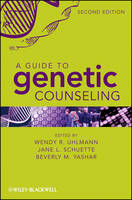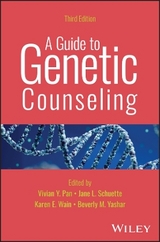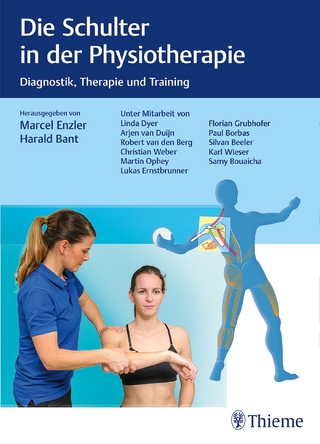
A Guide to Genetic Counseling
Wiley-Blackwell (Verlag)
978-0-470-17965-9 (ISBN)
- Titel erscheint in neuer Auflage
- Artikel merken
The first book devoted exclusively to the principles and practice of genetic counseling—now in a new edition First published in 1998, A Guide to Genetic Counseling quickly became a bestselling and widely recognized text, used nationally and internationally in genetic counseling training programs. Now in its eagerly anticipated Second Edition, it provides a thoroughly revised and comprehensive overview of genetic counseling, focusing on the components, theoretical framework, and unique approach to patient care that are the basis of this profession. The book defines the core competencies and covers the genetic counseling process from case initiation to completion—in addition to addressing global professional issues—with an emphasis on describing fundamental principles and practices.
Chapters are written by leaders in the field of genetic counseling and are organized to facilitate academic instruction and skill attainment. They provide the most up-to-date coverage of:
The history and practice of genetic counseling
Family history
Interviewing
Case preparation and management
Psychosocial counseling
Patient education
Risk communication and decision-making
Medical genetics evaluation
Understanding genetic testing
Medical documentation
Multicultural counseling
Ethical and legal issues
Student supervision
Genetic counseling research
Professional development
Genetics education and outreach
Evolving roles and expanding opportunities
Case examples
A Guide to Genetic Counseling, Second Edition belongs on the syllabi of all medical and human genetics and genetic counseling training programs. It is an indispensable reference for both students and healthcare professionals working with patients who have or are at risk for genetic conditions.
Wendy R. Uhlmann, MS, CGC is the genetic counselor/clinic coordinator of the Medical Genetics Clinic at the University of Michigan. She is a Clinical Instructor in the Department of Human Genetics and an executive faculty member of the genetic counseling training program. Jane L. Schuette, MS, CGC has been a genetic counselor for 26 years ansd is currently genetic counselor and clinic coordinator in the Division of Pediatric Genetics at the University of Michigan Health System. Beverly M. Yashar, MS, PhD, CGC is the program director for the genetic counseling graduate training program in the Department of Human Genetics at the University of Michigan.
Foreword xv
Preface xvii
Contributors xix
1 The Practice of Genetic Counseling 1
Ann P. Walker
The Practice of Genetic Counseling 1
Definition and Goals of Genetic Counseling 5
Components of the Genetic Counseling Interaction 11
Counseling Contexts and Situations 14
Providers of Genetic Counseling 16
Professional and Educational Landmarks in Genetic Counseling 19
Professional Growth and Skill Acquisition 25
Appendix: Practice-Based Competencies 26
Genetic Counselors’ Scope of Practice 30
References 32
2 The Ultimate Genetic Tool: The Family History 37
Jane L. Schuette and Robin L. Bennett
The Evolution of the Pedigree 38
Family History Basics 40
Gathering the Information and Constructing a Pedigree 43
Interpreting the Family History and Pedigree Analysis 57
Psychosocial Aspects of Obtaining a Family History 63
Summary 64
References 65
3 Interviewing: Beginning to See Each Other 71
Kathryn Spitzer Kim
Getting Started 71
Breaking the Ice 72
Setting the Stage: Core Qualities 73
Creating a Working Agreement 76
Verbal and Nonverbal Communication 80
Specific Interviewing Techniques 83
Obtaining Pedigrees 88
Assessment 89
Summary 90
Acknowledgments 90
References 90
4 Thinking It All Through: Case Preparation and Management 93
Wendy R. Uhlmann
Introduction 93
The Initial Intake 95
Billing Issues for Genetics Clinic Visits 96
Preparing a Case 97
Finding Information on Genetic Conditions 102
Practice Guidelines 103
Finding SupportAdvocacy Groups and Patient Resources 104
Performing a Risk Assessment 106
Locating and Developing Counseling Aids 112
Genetic Testing 113
Managing the Clinic Visit 125
Referrals to Other Specialists 128
Referrals of Family Members to Genetics Clinics 128
Case Documentation 129
Is a Genetics Case Ever Complete? 129
Conclusions 129
References 130
5 Psychosocial Counseling 133
Luba Djurdjinovic
Introduction 133
Psychosocial Assessment and the Structure of a Session 135
The Patient’s Story 136
Achieving Dynamic Psychological Engagement: The Working Alliance 137
Disruptions in the Working Alliance 144
Discussing Difficult Issues and Giving Bad News 148
Reactions and Psychologically Challenging Experiences 151
Counselees’ Coping Styles 154
Theories that Surround Our Work 155
Men in Our Practice 165
Supervision: Refining the Psychological Lens 166
Conclusion 167
References 168
6 Patient Education 177
Ann C.M. Smith and Toni I. Pollin
Sharing Expertise 178
Adult Learners 179
Models of Adult Learning 180
Genetic Counseling in the Information Age 181
The Genetic Counseling Session----A Vehicle for Patient Education 182
Additional Aspects of Patient Learning 188
Application of Instructional Aids for Patient Education 193
Tenets of Health Education and Promotion: Application to Genetic Counseling 196
Future Directions 200
Summary 201
References 201
7 Risk Communication and Decision-Making 207
Bonnie Jeanne Baty
Factors Impacting Risk Communication 208
Models of Risk Communication 213
Practical Aspects of Communicating Risk 213
The Family and Risk Communication 219
Factors Impacting Decision-Making 225
Models of Decision-Making 228
Practical Aspects of Decision-Making 233
Nondirectiveness 235
Use of Aids 236
Cultural Tailoring 238
Summary 240
References 243
8 The Medical Genetics Evaluation 251
Elizabeth M. Petty
Introduction 251
The Components of a Medical Genetics Evaluation 258
Diagnostic Studies 277
Tools and Resources of the Clinical Geneticist 278
Utility of Clinical Case Conferences and Outside Expert Consultants 279
Summary 280
References 281
9 Understanding Genetic Testing 283
W. Andrew Faucett and Patricia A. Ward
Introduction 283
Defining Genetic Testing 284
Test Parameters 285
Reasons for False Positives and False Negatives 289
Complexities of Negative Test Results 290
Variants of Unknown Significance 291
The ‘‘Ideal Genetic Test’’ 291
Ensuring Quality Clinical Genetic Testing 292
Development of a New Clinical Genetic Test 295
Global Testing Issues and Establishing Policy and Practice Guidelines 299
Complexities of New Technologies in the Genetic Counseling Session: Illustrative Cases 302
Conclusions 307
References 308
10 Medical Documentation 313
Debra Lochner Doyle
The Importance of Medical Documentation 314
When Should Medical Documentation Occur? 315
Who Records in the Chart? 316
Types of Medical Documentation 316
Recommendations for Medical Documentation 318
Disclosure of Information Contained in Medical Records 321
Medical Documentation for Billing and Reimbursement 322
Documentation That is Subject to External Review 323
Retention of Medical Records 324
Summar 325
Appendix: Patient Letter Outline 326
References 327
11 Multicultural Counseling 331
Gottfried Oosterwal
The Challenge 332
Multicultural Competency 333
Diversity is Cultural, Not Biophysical 333
The Religion Factor 335
American Values Compared 336
Four Basic Core Values 337
Pregnancy, Birth, and Family 344
Beliefs About the Causes of Disease and Disorders 349
Communicating Across Cultural Boundaries 351
Conclusion 357
Appendix: Responses to Critical Incidents 358
References 359
Further Reading 360
12 Ethical and Legal Issues 363
Susan Schmerler
Ethical Issues 364
NSGC Code of Ethics 372
Legal Issues 380
Areas of Practice Raising Ethical and Legal Questions 388
Conclusions 396
Reading List 396
13 Student Supervision: Strategies for Providing Direction, Guidance, and Support 401
Patricia McCarthy Veach and Bonnie S. LeRoy
Introduction 401
Definitions of Supervision 402
Genetic Counselors as Clinical Supervisors: Responsibilities 403
Supervision Goals and Discussion Topics 404
Supervisor and Student Roles 408
Student Responsibilities 411
Supervision Methods 413
Methods for Assessing Student Skills 416
Supervisee and Supervisor Characteristics 422
Common Supervision Challenges 425
Supervision Agreements for Clinical Supervision 429
Conclusions 430
Appendix: Example Clinical Supervision Agreement for the Genetic Counseling Setting 430
References 433
14 Genetic Counseling Research: Understanding the Basics 435
Beverly M. Yashar
Why Do Research? 436
Defining Research: AWay of Thinking 438
What Makes Scientific Knowledge Different? 438
Choosing an Experimental Approach 439
The Research Process 441
Data Collection and Analysis 454
Presentation: Pulling It all Together 455
The Human Side of the Equation–Ethical Research 456
Seeing It Through to the End 458
Conclusion 459
References 459
15 Professional Identity and Development 461
Elizabeth A. Gettig and Karen Greendale
Introduction 461
The Genetic Counseling Profession and Role Expansion 462
Professional Identity 463
Professional Conduct 466
Certification and Licensure of Genetic Counselors 467
Lifelong Learning Practices 469
Professional Opportunities in One’s Own Institution 473
Participation in Professional Organizations 475
Involvement in Policy-Making 476
A Final Thought on Professional Development 476
Acknowledgments 477
Appendix: Clinical Genetics Professional Societies 477
References 481
16 Genetic Counselors as Educators 485
Debra L. Collins and Joseph D. McInerney
Introduction 485
Education for Healthcare Professionals 486
Examples of Training and Continuing Education of Healthcare Professionals 488
Education for the Lay Public 491
Science Education Standards 491
Education for Students and Science Teachers 494
Education for Older Students (High School, College, and Adults) 495
Education for Young Students (Elementary to Middle School) 497
Teaching about Ethics and Public Policy 499
Effective Presentations: How to Prepare 502
Tips for Speaking with the Media 508
Developing Education Materials 509
Conclusion 509
References 509
Resources 510
17 Evolving Roles, Expanding Opportunities 523
Elizabeth A. Balkite and Maureen E. Smith
Introduction 523
Evolution of the Profession 524
Expansion of the Profession 525
Development of Clinical Specialty Areas in Genetic Counseling 526
Translatable Skills 528
Role Expansion: From the Traditional Genetics Clinic Setting and Beyond 530
Acquiring New Skills and Knowledge 531
Positioning Oneself for a New Role 537
Looking Ahead: Visioning 544
Conclusion 547
Appendix: Tools for Working Outside the Box: What Genetic Counselors can Bring to a Non-Traditional Role 548
References 551
18 Putting It All Together: Three Case Examples 553
Jane L. Schuette, Donna F. Blumenthal, Monica L. Marvin, and Cheryl Shuman
Introduction (Jane L. Schuette) 553
Pediatric Case (Cheryl Shuman) 554
Reproductive Genetics Case (Donna F. Blumenthal) 567
Cancer Genetics Case (Monica, L. Marvin) 575
References 591
Index 597
| Erscheint lt. Verlag | 4.9.2009 |
|---|---|
| Zusatzinfo | Photos: 20 B&W, 0 Color; Drawings: 30 B&W, 0 Color |
| Verlagsort | Hoboken |
| Sprache | englisch |
| Maße | 152 x 229 mm |
| Gewicht | 907 g |
| Themenwelt | Medizin / Pharmazie ► Gesundheitsfachberufe |
| Medizin / Pharmazie ► Medizinische Fachgebiete | |
| ISBN-10 | 0-470-17965-1 / 0470179651 |
| ISBN-13 | 978-0-470-17965-9 / 9780470179659 |
| Zustand | Neuware |
| Haben Sie eine Frage zum Produkt? |
aus dem Bereich



